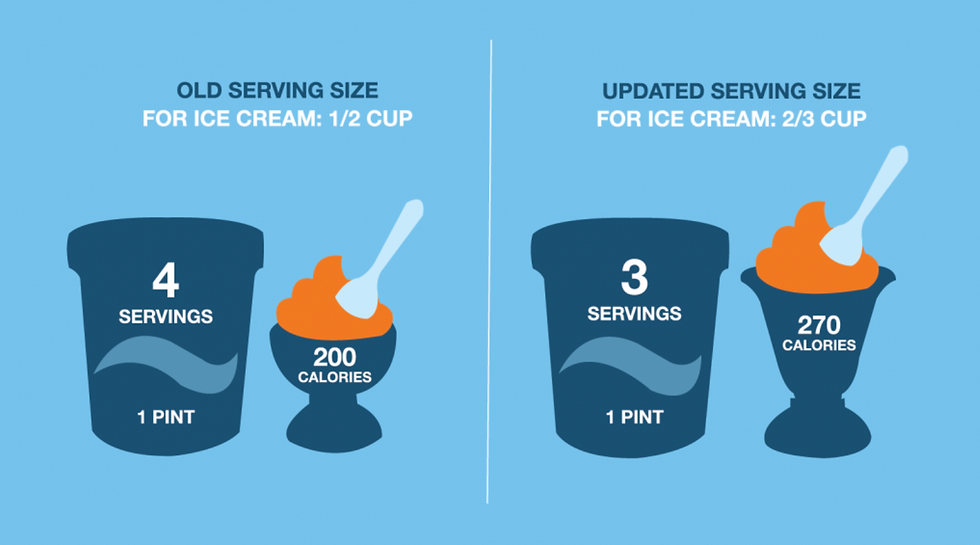Other Vendors Teach Employees to Read Those "Nutrition Facts." We Teach Them Not to.
- Al Lewis

- Jan 8, 2024
- 6 min read
Updated: Jan 19, 2024
There are only 14 lines on these labels. And yet somehow 10 of them are either useless or actually misleading.

How can that be, you ask? We didn’t think it was possible either. But as part of our 7-step Weight Loss Drug coverage strategy (the 11-month curriculum to support GLP-1 users who press on after our Curb Their Enthusiasm quiz), we set out to prepare questions to guide on how important it is to read the labels and follow the guidelines. But we found just the opposite.
Each of the numbered observations below is keyed to the sample label above.
1: Serving Sizes
The Serving Sizes used to be way too small. Recently they’ve been increased, in an attempt to keep up with Americans’ increasing appetites. Here is an example of an increase:

Likely we are eating more not because we've all gotten hungrier, but because the processed food industry has figured out how to get us to eat more.
We say "attempt to keep up" because what they consider a serving and what you consider a serving might be two different animals, as the next section shows.
2: Calories
Taking the Calories number literally yields some squirrely results. Like one cup of Froot Loops and one cup of Special K have the same number of calories: 117. This is because all are carbs, and every digestible carb has the same number of calories. They are assuming this is one serving.
But how does that "serving" compare to what you get served at a restaurant? And restaurants are where you really need to read these Calories labels.
Example: a "personal" 9-inch Pizza Hut pizza is 1470 calories. Um, that's one serving? Even if you split it, it's still 735 calories.

3(A): Fat (Total, Saturated, and Trans)
Let’s start with Total Fat. The example label says “10%.” 10% of what? Is 100% the most you should get, like sugars, or the least you should get, like vitamins?
The answer: fuhgeddaboudit. Some fats, like olive oil, are good. Others are generally believed to be bad. It also depends on the individual. There is no right answer here, so to list a “% Daily Value” of “10%” when the “100%” is meaningless is truly a head-scratcher.
The next line is Saturated Fat. We were all taught to believe that saturated fat was bad. That’s partly because some may indeed be unhealthy, but largely because two prominent researchers were bribed by the sugar industry to demonize fat, especially saturated fat.
Not unlike with Total Fat, some saturated fats are good for most people, and some are widely believed to be bad. Dairy fat has been enjoying a renaissance lately. These new findings are still controversial, but, having read everything pretty closely, I myself have completely switched to whole milk. One thing for sure: regardless of whether you believe the new research or not, most full-fat yogurts are healthier than most nonfat yogurts for the simple reason that most (not all) nonfat yogurts are full of sugar.
A Quizzify rule of thumb for yogurt: if a yogurt is sweet and especially if you "stir fruit up from bottom," it is likely full of sugar.
Other sources of saturated fat are more controversial. is coconut oil good or bad? Is saturated fat from meat good or bad?
Whatever the answer, it is quite clear that the 100% recommendation is once again meaningless. It is a hermaphroditic mishmash of likely good (dairy), likely bad (highly processed meat and tropical oil products) and controversial (everything else) types of saturated fat.
That brings us to artificial Trans Fats. They are mostly removed from the food supply due to some very convincing research. So why waste valuable real estate on this short label to state "0%"? (A few trans fats linger in commercial baked goods despite the "0%", so the label is actually misleading in that respect, too.)
A conspiracy theorist might say it's to make us feel good about buying the product. Most non-conspiracy theorists would agree.
Instead of reading the "Facts," read the ingredients. If there are lots of them and/or you don't recognize them, put the product back on the shelf.
3(B): Cholesterol
Where to start? First, dietary cholesterol is of no negative consequence whatsoever to 99.5% of the population. (The other 0.5% should presumably already know their risk. They have "familial hypercholesterolemia," a condition that even a single doctor visit/lab test would identify or confirm.)
Quite the opposite, some of the most nutritious foods, like eggs, are full of dietary cholesterol. It's not just that they are good for us. It's that whatever else we would eat for breakfast instead would almost certainly be worse.
There are also many processed foods that shout CHOLESTEROL FREE or CONTAINS NO CHOLESTEROL that are among the most unhealthy things you can buy, as they are usually full or sugar. Yet, people see that "0%" on the label and assume that a low number is good, when it's usually just the opposite.

3(C): Total Carbohydrates and Fiber
This "% Daily Value" is the most misleading of all.
You know the old joke about the statistician saying if your head is in the freezer and your feet in the oven that you are comfortable on average?
Well, Total Carbohydrates include both the worst thing in our diet that we get much too much of (added sugars) and the arguably most important thing in our diet that we don't get remotely enough of (fiber).
The next line down is exactly that, Dietary Fiber. Fiber is technically a carbohydrate. So this is the completely appropriate place to list fiber, if indeed you are taking your biochemistry midterms. It is a completely inappropriate place if you are writing a food label. Whole grains and especially oatmeal, nuts, legumes (peas, beans etc.) and many other plant-based foods are excellent sources. Other foods have zero.

Those of you using the Quizzify Weight Loss Companion Quiz Set have certainly seen the emphasis those questions place on fiber intake. If we don't get enough to begin with, we're cutting our food intake in half, and we are having digestive complications anyway (covered in our Digestive Side Effects quiz), the importance of consuming enough fiber is paramount. It's the most important thing on the entire Nutrition Facts label. And yet, it's buried in a place it will likely not even be noticed, where a high "% Daily Value" is a good thing, sandwiched between two line items where a high % Daily Value is a bad thing.
One idea – and far be it from me to tell these very stable geniuses how to do their job – is that good % Daily Values should be in green, bad ones in red, and controversial or unsettled ones in yellow. Just sayin'...
3(D) Total Sugars and Added Sugars
Which brings us to the worst "bad thing" on this list, which is Total Sugars. As with fiber, this items should be far more prominent. For some reason there is no % Daily Value for Total Sugars, just for Added Sugars.
High consumption of both, but especially added sugars, is a major health hazard for most people. This line was added in 2020, and is quite useful, arguably the second-most useful item, after Dietary Fiber.
Consider this product. You'll note it says "NO SUGAR ADDED. But if you look at the actual Nutrition Facts label, it lists 53 grams of sugar. (By contrast, a can of Coke has 39 grams. And in both cases, that is more than we should eat in a day.)

How can that be, you ask? It turns out that sugars derived from concentrated fruit juice that are considered "added" for any other product are considered "natural" when sweetening juice products. This is all spelled out here.
3(E): Protein
Americans generally get far more protein than their body can possibly use. This is really not harmful, other than displacing foods in our diet which would be beneficial in other ways.
A few people don't get enough. Vegetarians, especially vegans, need to pay close attention. And people on weight loss drugs will lose muscle mass – as is covered in our initial "Curb Their Enthusiasm" quiz and throughout our Weight Loss Drug Companion curriculum – but weight-bearing exercise and adequate protein should help in improving the muscle-to-fat ratio.
So we really have no major objections here, which is high praise indeed.
4: Vitamins

Seriously, do you even know anyone who knows anyone with a vitamin deficiency? For every commercially insured American who has a clinically significant vitamin deficiency, there are probably 10,000 with elevated or high blood sugar. To the credit of the folks who design these labels, they've pushed the vitamins and minerals to the end, and only list a few of them.
I suppose they have to be listed, but the rate of clinically significant vitamin deficiency amongst the subset of Americans who actually read these Nutrition Facts is approximately: 0.
There is also a downside to any emphasis on vitamins, and the "Cholesterol Free" label above is a perfect example of it: most ultraprocessed foods with vitamins added are basically junk. Eat This Not That has an entire category of unhealthy healthy-sounding cereals packed with vitamins and synthetic (and basically worthless) antioxidants, of which Smart Start is rated number one. Both this and the Cholesterol Free examples are "teaching to the test."
Meaning that instead of actually being healthy foods, they are simply trying to create a perception that they are healthy foods. Often those two goals are in direct conflict.
Nutrition is in the spotlight these days, largely because improving nutrition is a major focus of the education needed to accompany a course of weight-loss drugs.
Quizzify leads the field in this respect. Example: did you know any of stuff in this posting? And now imagine you are on GLP-1s and nutrition is a major concern of yours, because you are eating so much less food. And because you want to learn how to keep the weight off once your course of weight-loss drugs ends. We've got this...




